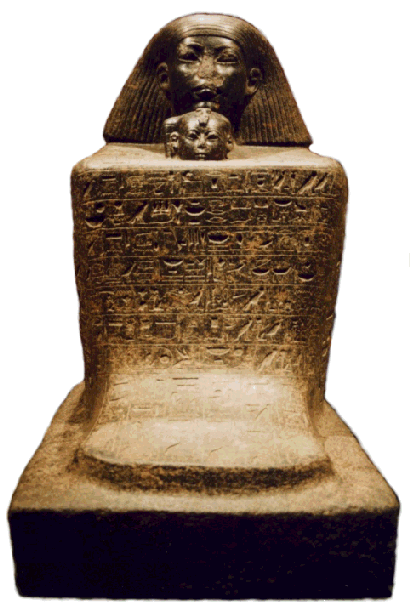|
Senenmut |
last update: 01.01.2010 | |
|
Cryptograms on Tutor Statues |
| On three of his tutor statues all constructed as block statues (Berlin No. Senenmut 2296, Cairo CG 42114 and 42116) Senenmut let engrave on the surface of each statue on both sides in front of the wig a strange figure. |

| Tutor statue of Senenmut with Neferu-Ra, Ägyptisches Museum, Berlin No. 2296 |

| Above the drawing on the left side of the upper surface of the cube, below the drawing of the right side (photos: L. Franke). |


 |
 |
| On the left a drawing of the figure carved on the left side (frontal view) of the upper surface of the cube, i. e. in front of the right shoulder of Senenmut, on the right the figure carved on the right side (from: Drioton, ASAE 38, 1938).. |
| The meaning of these figures were unknown for a long time until Drioton (ASAE 38, 1938, 231-246) solved the riddle. |
| The basic form of the left figure is the shape of a flying vulture which reminds of the crown goddess Nekhbet. The figure is supplemented by an "Udjat" eye, which forms a part of the body, and by an Ka-sign, which is seized by the claws of the Nekhbet in place of the Shen-ring (which is usually hold by the claws of Nekhbet). |
| The cosmic aspect of Nekhbet, who is regarded also as "right eye of Ra", leads to the goddess Maat. The Maat herself is connected with the body of the sun, which is her meat and her bones, therefore the Maat represented by all elements of the eye surrounding the pupil. |
|
The Udjat-eye symbolizes the sun god Ra. |
| According to Drioton all signs have to be read together as the throne name of Hatshepsut - Maat-ka-Ra. |
| The basic form of the right figure is a walking man, who carries a long stick in one hand and an anx in the other. The long stick has the from of a wAs-sign. The face of the figure is invisible. On the head the figure carries a combination of the two signs wAs and anx. |
| According to Drioton the invisible face of the head stands for the Egyptian words Imn-@At (Imn = hidden and HAt = front of the body or face, first). |
| The combination of the signs wAs and anx on the head is to be read after Drioton as "noble (= Sps)" things "united (= Xnm)" on the head. |
| Read in the correct order the words form the birth name of Hatshepsut = @At-Spswt-xnmt-jmn. |
| One may of course interpret the encrypted figures on these block statues as a sign of a special admiration of queen Hatshepsut by Senenmut. His special admiration is documented elsewhere, e.g. n the 2 scenes in the decorated first chamber of TT353 where Senenmut is shown worshipping the names of Hatshepsut. |
| However, further statements about the relationship between Senenmut and Hatshepsut can not be derived from these cryptograms - and any conclusion drawn on these figures must be considered to be highly speculative. |